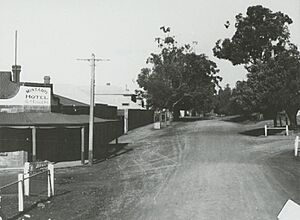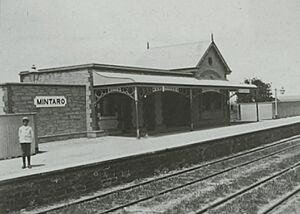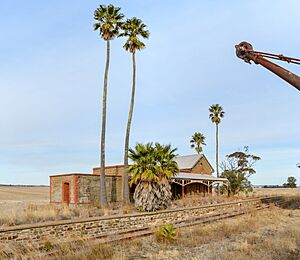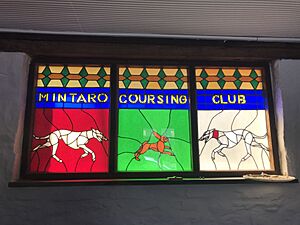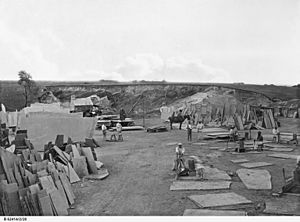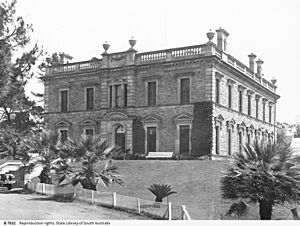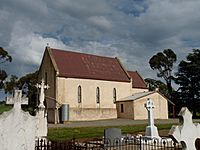Mintaro, South Australia facts for kids
Quick facts for kids MintaroSouth Australia |
|||||||||||||||
|---|---|---|---|---|---|---|---|---|---|---|---|---|---|---|---|
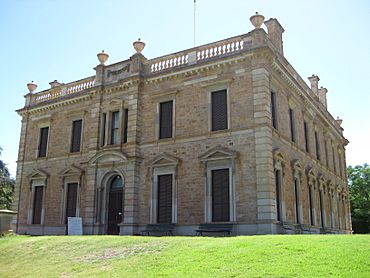
Martindale Hall
|
|||||||||||||||
| Established | 1849 | ||||||||||||||
| Postcode(s) | 5415 | ||||||||||||||
| Location | |||||||||||||||
| LGA(s) | District Council of Clare and Gilbert Valleys | ||||||||||||||
| Region | Mid North | ||||||||||||||
| State electorate(s) | Frome | ||||||||||||||
| Federal Division(s) | Grey | ||||||||||||||
|
|||||||||||||||
Mintaro is a small, historic town in the beautiful Clare Valley in South Australia. It's about 126 kilometers (78 miles) north of Adelaide. The town was started in 1849 by Joseph and Henry Gilbert. They divided the land into many small blocks.
Mintaro was first planned as a resting spot for bullock teams. These teams carried copper ore from the Burra mine to Port Wakefield. By 1876, about 400 people lived here. Mintaro grew as a service center for farms in the 1870s and early 1880s. After 1930, fewer people lived in rural areas, and the town didn't grow much for many years.
The Mintaro area is home to famous properties like Martindale Hall and Kadlunga. Mintaro is also known for its high-quality slate. This slate comes from what is thought to be Australia's oldest working quarry. Even though farming is still important, tourism is growing. Because of its history, the whole town of Mintaro was made a State Heritage Area in 1984. This means its special buildings and history are protected.
Contents
Exploring Mintaro's Location
Mintaro is in the eastern Clare Valley, about 126 kilometers (78 miles) north of Adelaide. It's located east of the Horrocks Highway. The town sits in the hilly Mid North region of South Australia. It's also part of the famous Clare Valley wine region. This area has valleys that are 300 to over 500 meters (980 to 1,640 feet) above sea level. The town is in a valley below Mount Horrocks. It's at the meeting point of several roads.
Mintaro's Weather
Mintaro has a Mediterranean climate. This means it has warm to hot summers and cool, wet winters. Average daily temperatures are about 8.0°C (46.4°F) in winter. They reach about 21.4°C (70.5°F) in summer. The town gets about 632mm (25 inches) of rain each year. Most rain falls in winter and spring. Sometimes it hails, and rarely, it even snows.
Plants and Animals in Mintaro
Before Europeans arrived, the Clare Valley had grassy woodlands and open grasslands. This provided lots of food for the local Ngadjuri people. Common native trees include blue gum and peppermint gum. You can also find red stringybark and Casuarinaceae (also called sheoak). The Spring Gully Conservation Park is about 15 kilometers (9 miles) west of Mintaro.
Mintaro's Past: A Journey Through Time
The Ngadjuri people were the first inhabitants of the Clare Valley. They lived here for thousands of years before Europeans came. It's believed they had major camping spots in areas like Clare, Auburn, and Mintaro.
Europeans first explored the Mintaro area in 1839. This was done by John Hill and then Edward John Eyre. Land in the Barossa and Clare Valleys was quickly settled in the early 1840s. The first settler in Mintaro was pastoralist James Stein. From 1841, he had licenses for large sheep farms. His homestead was near Mount Horrocks, about three kilometers (1.9 miles) west of today's Mintaro.
When copper was found at Kapunda in 1844 and Burra in 1845, the area became very popular. In 1848, the Patent Copper Company built the 'Gulf Road'. This road connected the Burra Mine to Port Wakefield. Along this road, bullock teams carried copper ore to the port. They returned with coal and supplies. Towns like Mintaro were built about 14.5 kilometers (9 miles) apart. This was because it was the distance a bullock team could travel in a day.
Mintaro was built on land bought by Joseph and Henry Gilbert. They divided the land into 80 blocks in 1849. The town was meant to be a resting place for the bullock teams. The first blocks sold in Mintaro faced the Gulf Road, which is now Burra Street. This is why Mintaro's early streets are angled differently from other roads.
The Magpie and Stump Hotel opened in December 1850. The years from 1850 to 1860 were very good for Mintaro. Many of the town's buildings were built during this time. Important slate deposits were found in the early 1850s. The Mintaro Slate Quarry opened in 1854. By the early 1860s, Mintaro slate was famous. By the early 1880s, about 50 men worked at the quarries.
The town's growth slowed when the railway opened from Adelaide to Gawler in 1857. Copper teams then used a different route. However, the slate quarries were growing, and a flour mill was built in 1858. Mintaro became a service center for nearby farms. These farms supplied the mining towns of Kapunda and Burra. The population grew, and in 1866, the town expanded.
In the 1860s and 1870s, public buildings like a school appeared. Many Irish Catholics also settled in the area. In 1876, the population reached 400. The Burra mine closed in 1877. But Mintaro kept growing as a farming service center. This was because farming was doing very well in the Mid North region.
The Mintaro railway station was built in 1870. It was about 7 kilometers (4.3 miles) east of the town. In 1918, it was renamed Merildin. Mintaro continued to do well as a farming center. This was even after the Burra mines closed. The rich farms in the Gilbert Valley benefited from good wheat and wool prices. This wealth led to two large properties near Mintaro. Martindale Hall, built in 1879-80, and Kadlunga homestead, bought by Sir Samuel Way in 1881, showed a lifestyle like that of English nobility. Mintaro provided workers for these large estates.
Live hare coursing was held from 1884 to 1986 by the Mintaro Greyhound Coursing Club. This activity stopped due to new laws. Drag lure coursing continued until 1997.
The early 1900s were good for rural areas. But after the 1929 Depression, fewer people lived in the countryside. The slate quarry helped Mintaro survive. But the town didn't develop much for several decades.
Mintaro was named a State Heritage Area in 1984. This protects its special history and buildings. In recent years, old buildings have been fixed up for tourism. There has also been more residential development. Passenger trains stopped going through Mintaro in 1986. Grain trains continued until 2004.
How Mintaro Got Its Name
There are different ideas about how Mintaro got its name. Some thought it was Spanish. But now it's believed to be an Aboriginal word.
In 1892, Sir F. W. Holder suggested the local Ngadjuri word "Mintadloo" might have changed into Mintaro. This idea was supported by early farmer Thomas Goode. He said, "the blacks called the area 'mintadloo' but I don't know what it means." Later, historian Geoff Manning said the name came from mintinadlu. This word means 'netted water'. It might refer to how Indigenous people used nets to catch animals like emus and kangaroos.
Another idea from a 1908 newspaper article says Mintaro is Spanish. It means 'camping place' or 'resting place'. This is because Spanish-speaking mule drivers from South America used Mintaro as a resting spot. They carried copper ore from the Burra Mine. Between 1853 and 1857, many mule teams passed through the town daily. However, there are not many Spanish words similar to Mintaro.
The area was sometimes called Mintara in early ads. The name Township of Mintaro first appeared in 1849. People in the Clare Valley say the town's name as "min-TAIR-oh".
Mintaro's Famous Slate
Mintaro slate comes from Australia's oldest continuously working quarry. A local farmer found the slate in the early 1850s. In 1856, Thompson Priest, an English stonemason, started mining the slate. Cornish Methodist miners were brought from England to work there. The open-cut quarry is about 1.5 kilometers (0.9 miles) west of the town.
By 1860, Mintaro was South Australia's top producer of high-quality slate. Mintaro slate was shown at the 1862 London International Exhibitions. It won awards for its large size and flat surface. In 1910, it was called some of the finest stone in the world. Its perfectly flat surface makes it great for billiard and pool tables. Walter Lindrum, a world champion billiard player, said Mintaro slate was excellent. He even practiced on a table made from a single slab of Mintaro slate. Tennis player Lleyton Hewitt also has tables made from Mintaro Slate.
The slate was first used for local buildings. It was also used for fermenting tanks at wineries. It made acid leaching tanks at copper mines. It was used for cricket pitches, water troughs, tombstones, and blackboards. Many old homes in Mintaro are built from this local slate.
After Thompson Priest died in 1888, a Melbourne company bought his quarry. During the tough economic times of the 1890s, the quarry produced less slate. In 1911, a local group formed the Mintaro Slate and Flagstone Company Limited. They bought more land and increased slate production. In 1981, the quarry was sold again and became Mintaro Slate Quarries Pty Ltd.
Mintaro slate is part of the Mintaro Shale Formation. It formed on the sea floor about 800 million years ago. Many famous buildings in Adelaide use Mintaro slate. These include Parliament House, St Francis Xavier Cathedral, and the South Australian Museum. Mintaro slate has been used in every Australian city. Today, it's used for paving, kitchen tops, fireplaces, and more. It's still famous worldwide for billiard tables.
Martindale Hall: A Grand Mansion
Martindale Hall is a beautiful mansion listed on the South Australian Heritage Register. It looks like a grand English country house. The Hall is on 19 hectares (47 acres) of land, about 2.5 kilometers (1.6 miles) south of Mintaro. Edmund Bowman built it after inheriting the Martindale Estate. It was finished in 1880. The mansion was built using freestone from nearby quarries. Most of the skilled workers came from England. The house cost about £30,000 (around A$5.62 million today) to build. Bowman was a well-known pastoralist and used the property for sheep farming.
In 1890, after some difficult years, Bowman had to sell Martindale Hall. William Tennant Mortlock bought it in 1892. Mortlock continued sheep farming and improved the gardens. He was also interested in horse racing. He bred a horse that won a big race in 1911. Mortlock was also a member of the State Parliament.
When William Mortlock passed away in 1913, his son, John Andrew Tennant Mortlock, inherited the estate. He lived at the Hall and became a successful farmer and Merino sheep breeder. John loved to travel and filled the Hall with items from Africa and Asia. These include a real 16th-century Samurai suit. He was also a keen yachtsman and amateur filmmaker. John Mortlock died in 1950 without children. His wife inherited the Hall. She moved to Adelaide, and the mansion was empty for nearly 30 years. In 1979, she left Martindale Hall to the University of Adelaide. It was listed as a state heritage place in 1980.
In 1986, the University gave Martindale Hall to the South Australian Government. In 1991, the land became the Martindale Hall Conservation Park. From 1991 to 2014, the property was leased out for tourism. It offered bed and breakfast stays, weddings, and tours. Since 2015, the government has managed it. There was a plan to turn it into a luxury resort. But the National Trust wanted it to stay open to the public.
The famous Australian film, Picnic at Hanging Rock, was partly filmed at Martindale Hall in 1975. The Hall is still open to the public and gets about 100,000 visitors each year.
Kadlunga: A Historic Farm Estate
The heritage listed Kadlunga is a large farm property. It covers about 2,367 hectares (5,850 acres). It's located about 3 kilometers (1.9 miles) west of Mintaro. Kadlunga is known as one of the most historic properties in the Mid North area. Three rivers flow through the property: Broughton, Wakefield, and Hutt. It gets about 600-650mm (24-26 inches) of rain each year. It also has many dams, bores, and wells.
Pastoralist James Stein was the first European settler at Kadlunga in 1841. He had licenses for large sheep farms. Stein built his homestead near the Wakefield River. He named it Kadlunga, which is an Aboriginal word meaning 'sweet hills'. This was because of the many honeysuckle plants there. The original two-story homestead was built in 1857.
Sir Samuel Way, a Chief Justice of the Supreme Court of South Australia, bought Kadlunga in 1881. In the following years, Kadlunga Station became famous for its sheep and horse breeding. The first Percheron horses in Australia came to Kadlunga in 1915. The Gosse family owned the property for over 100 years. They sold it in 2017.
The original 1857 house was almost completely rebuilt in 1919-20. The old stone was covered to match the new walls. The house now has fifteen rooms. All the inside features are from the 1919-20 changes. Italian prisoners of war built many dry stone walls on the farm during World War II. Kadlunga's historic stone buildings are listed on the Australian Heritage Database. This is because of their architecture and connection to important people.
Merildin: A Nearby Locality
Merildin is a historic area next to Mintaro. It is now part of the Mintaro locality. The Mintaro Railway station was built about 7 kilometers (4.3 miles) east of Mintaro in 1870. It was on the northern line to Burra. In 1918, it was renamed Merildin station. Merildin is considered the main water collection area for the upper Wakefield River. The name Merildin comes from an Indigenous word meaning "stopping place".
Mintaro Today
Mintaro is a special example of a well-preserved village from the mid-1800s. Thirty-three specific sites in Mintaro are state heritage-listed. The town also offers places for tourists to stay. Mintaro's main shops and most of its old buildings are on Burra Street. The town is quite isolated, with not much development around it.
The historic center of Mintaro has many early Victorian buildings. These buildings help make it a state heritage area. In the past, the town had all the basic services for its people. Today, many of these old buildings are now guest houses. It has several bed and breakfast places and a hotel. There are also two winery cellar doors, galleries, eateries, a gift shop, and a hedge maze. Mintaro is still a farming community, surrounded by vineyards and farms.
A large solar farm was proposed in 2017. It would be called the Chaff Mill Solar Farm. It would be located about 3.5 kilometers (2.2 miles) northeast of the town.
Farming in Mintaro
Mintaro is mainly a farming community. It is surrounded by mixed farms and vineyards. Both are very important to the region and South Australia's economy. The main type of farming is pastoralism. You can often see wheat and canola fields in the Mintaro area.
The Clare Valley is one of Australia's oldest wine-producing areas. It has been making wine for over 150 years. It's famous for its Riesling wine. But it also makes other wines like Cabernet Sauvignon and Shiraz. Today, there are over 5,000 hectares (12,355 acres) of vineyards. There are also more than 40 places where you can taste wine.
Who Lives in Mintaro?
The 2016 Australian census showed that Mintaro had 188 people. There were 93 males and 95 females. No Aboriginal or Torres Strait Islander people were recorded. The average age was 54 years. Children (0 – 14 years) made up 14% of the population. Most people (81.4%) were born in Australia. The most common backgrounds were English (38.7%), Australian (27.7%), and German (10.6%).
How Mintaro is Governed
Mintaro is managed by the District Council of Clare and Gilbert Valleys. At the state level, Mintaro is in the electoral district of Frome. Federally, it's in the electoral division of Grey. Any new building in the town needs special heritage approval. The local group is the Mintaro Progress Association. They work with the council to make sure local issues are heard.
Sports in Mintaro
The MINMAN Sporting Club brings together the Mintaro and Manoora Australian rules football and netball teams. The football team is called the Eagles. They play in the North Eastern Football League. The netball club plays in the North Eastern Netball Association. Their home games are at Mortlock Park in Mintaro.
The Mintaro Bowling Club started in 1959. They have men's, women's, and social competitions. Games are played on a grass surface on Burra Street. Also on Burra Street is the Mintaro Tennis Club. It has three synthetic grass courts.
The Auburn-Mintaro Cricket Club combines players from Auburn and Mintaro. They are called the Bullants. They play in the Stanley Cricket Association. Home games are played at the Auburn recreational grounds.
Tourism in Mintaro
Even though Mintaro is mainly a farming town, tourism is becoming very important. This is especially true for the wine industry. Many historic bed and breakfast places are in town for visitors.
The best way to see Mintaro is by walking. You can take self-guided tours to see the historic buildings. These tours can take up to two hours. The Mintaro Garden Rooms are on Kingston Road. This award-winning garden is open to the public. It's popular for weddings and picnics.
The Clare Valley gourmet weekend started in 1984. It's held every May to celebrate the end of the wine-making season. Visitors can learn how wine is made and try local food. Live music is played at some wineries. The traditional living hedge maze is on the corner of Jacka Road and Wakefield Street. It was built in 1995 with over 800 conifer plants. It's open most days. The Mintaro Maze Bunny Hunt is held at Easter. The Haggis Hunt happens during the gourmet weekend.
A short drive from Mintaro is the Polish Hill River Church Museum. It opened in 1996. The museum shows how Polish migrants helped develop South Australia. It's open on the first Sunday of each month. Mintaro is also a popular place for bicycling. The Clare Classic road cycling event goes through Mintaro.
Famous People from Mintaro
| Image | Name | Connection to Mintaro | Reference |
|---|---|---|---|
 |
Edmund Bowman Jr (1855–1921) | Owned part of the Martindale estate and built Martindale Hall. | |
 |
William Brown (1868–1930) | Born in Mintaro. He became a professor of law and a political thinker. | |
 |
John Chewings (1819–1879) | Owned and lived at Kadlunga. He was a landowner and supplied goods to the area. | |
| Peter Cloke (born 1951) | Played Australian rules football for Richmond and North Adelaide. He lives in Mintaro. | ||
 |
Hugh Fraser (1837–1900) | Worked at the Mintaro slate quarry for four years. Later became a politician in Adelaide. | |
| Percy Hutton (1876–1951) | Born in Mintaro. He played one first-class cricket match for South Australia. | ||
 |
Norman Jolly (1882–1954) | Born in Mintaro. He was the first South Australian to get a Rhodes Scholarship. He was also a good cricketer and football player. | |
| Michael Kelly (1905–1967) | Born in Mintaro. He was a rheumatologist (a doctor for joint diseases). He won the Geigy prize in 1958. | ||
 |
Charles Kimber (1826–1913) | Worked as a farmer in Mintaro. He was elected to the South Australian Parliament. | |
 |
Alexander Melrose (1889–1962) | Owned and lived at Kadlunga, where he bred sheep, cattle, and horses. He was a politician. | |
 |
John Mortlock (1894–1950) | Born and lived in Mintaro. He owned Martindale Hall and was a successful sheep breeder. | |
 |
William Mortlock (1858–1913) | Bought Martindale Hall in 1891 and was a successful farmer. He was also a politician. | |
| Frederick Muir (1849–1921) | Born in Mintaro. He played one first-class cricket match for Otago in New Zealand. | ||
| John Jackson Oakden (1818–1884) | An early business partner of James Stein. He managed the Kadlunga property for a time. | ||
 |
James Stein (1804–1877) | An early settler of the Mid North of South Australia. He founded the Kadlunga farm estate. | |
| Alfred (Jack) Tanner (1887–1955) | An expert in beef cattle. He worked at Kadlunga early in his career. | ||
| James Torr (1816–1894) | Arrived in Australia in 1847 and settled in Mintaro. He was a landowner and farmer. | ||
 |
Samuel Way (1836–1916) | Chief Justice of the Supreme Court of South Australia. He owned Kadlunga for 35 years. | |
 |
Lawrence Weathers (1890–1918) | An Australian soldier who received the Victoria Cross for bravery. His family settled in Mintaro when he was a child. | |
 |
George Young (c. 1822–1869) | Lived in Mintaro as a surveyor and land agent. He represented the area in the South Australian Parliament. |
Gallery




